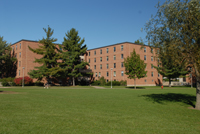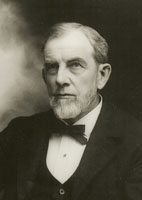UNIVERSITY OF WISCONSIN River Falls
History of Buildings and Areas
Parker Hall

When the new Normal School opened in 1875, the first President, Warren D. Parker, and a faculty of eight organized classes that would start the students on the road to becoming teachers. As one of them recalled later it was “a cosmopolitan group, gathered from all parts of the state. ... There were two figures that stand out prominently on that morning, one was Thomas J. Martin, our first janitor, and the other, W. D. Parker, the first president, and I confess that on that day, I stood as much in awe of the one as the other.” By 10 o’clock that morning, the President had divided the students into five sections and the first River Falls Normal School was under way.
Parker’s family were New Englanders who immigrated to Wisconsin when he was 14 years old, locating near Janesville where he could get a high school education and later attend the University of Wisconsin at Madison. In subsequent years he became a teacher, superintendent of high schools and state inspector of high schools who helped set standards in schools throughout Wisconsin. He also organized and served as superintendent of the first school for the blind.
 He was appointed president of the River Falls Normal in 1874 and came to this new region of Wisconsin where a normal school had been authorized the year before despite bitter opposition from other towns that wanted it. By 1875, there was a building now known as South Hall, but not even a railroad to bring students to town from the region. There were no sidewalks except on Main Street, no electric lights, one well with a pump and tin cup attached. But students remembered not the hardships of travel or the inconveniences of starting to become teachers in a new school, but only the daily assemblies when President Parker read excerpts from good books and gave short speeches to encourage the students to become honorable leaders of children. One favorite quotation from Jonathan Edwards was: “Resolved never to do anything which I would be afraid to do as if it were the last hour of my life.” The daily assemblies ended with his favorite song “A Perfect Day.”
He was appointed president of the River Falls Normal in 1874 and came to this new region of Wisconsin where a normal school had been authorized the year before despite bitter opposition from other towns that wanted it. By 1875, there was a building now known as South Hall, but not even a railroad to bring students to town from the region. There were no sidewalks except on Main Street, no electric lights, one well with a pump and tin cup attached. But students remembered not the hardships of travel or the inconveniences of starting to become teachers in a new school, but only the daily assemblies when President Parker read excerpts from good books and gave short speeches to encourage the students to become honorable leaders of children. One favorite quotation from Jonathan Edwards was: “Resolved never to do anything which I would be afraid to do as if it were the last hour of my life.” The daily assemblies ended with his favorite song “A Perfect Day.”
Crisis struck the Normal School in 1897 when fire destroyed what some called the “Cathedral of Learning.” Before the fire had leveled the building, Parker mounted a nearby wagon to announce that classes would meet the next day downtown and called a meeting of townspeople arranging meeting rooms for months ahead. Later he proudly said that the fire cost the students only one-half day of classes.
Parker was one of the influential educators of the Midwest. He was a pioneer in establishing schools in Wisconsin and in making studies relate to everyday life. A colleague said of him that he was “a well-rounded and unusual man. ... Whatever profession he might have chosen he would have adorned; whatever pursuit might have won his endeavors he would have been recognized among its leaders. ...”
Though the Normal School had an enrollment of only 308 students when he retired because of ill health after serving 18 years (1875-1889; 1894-1898), he left behind a well-established teacher training institution. When he died in California in 1920, there was a community memorial service at the Normal that included students, alumni and townspeople. The service began with the glee club singing “Auld Lang Syne,” followed by speeches praising his contribution to River Falls and closing with “A Perfect Day.”











